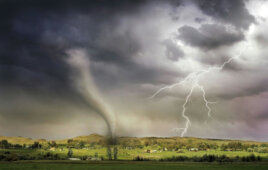 The wind industry trends – in a nutshell – are moving toward larger turbines to take advantage of the economy-of-scale, along with greater reliability and efficiency to bring down the cost of wind-generated power. The wind industry’s goal is to rival the cost of electricity generated from natural gas.
The wind industry trends – in a nutshell – are moving toward larger turbines to take advantage of the economy-of-scale, along with greater reliability and efficiency to bring down the cost of wind-generated power. The wind industry’s goal is to rival the cost of electricity generated from natural gas.
Launching larger turbines is almost a race between the OEMs. Just a couple years ago, three companies announced 10-MW turbines on their drawing boards, while one study of the day suggested a 12-MW turbine was possible with the current technology. The 10-MW units have since disappeared from the news because OEMs learned that jumping to 10 MW is a much longer leap than anticipated. Instead, they are happy to accept kudos for 6 and 7 MW turbines. Vestas has announced an 8-MW unit with a drivetrain and blades ready for tests this year.
The trend toward greater reliability is seen, for example, in a better understanding of how gearboxes fail. Presenters at a recent meeting of the NREL sponsored Gearbox Reliability Collaborative showed photos of microscopic points of initiation in failed bearing material. A theory suggested is that failures are triggered by impact loads. Another presenter suggested that the impact loads come from torque reversals, an event common to shutting down for high winds and even more so in emergency stops. If torque reversals can be tamed, impact loads can be minimized, and bearing life and hence gearbox life, will lengthen.
Of course, direct-drive turbines will never suffer a gearbox failure. Those 5 to 7-MW units headed for offshore duty will use permanent magnet (PM or direct-drive) generators. News in the previous issue reported on one promising PM-generator design that aims to take weight out of the nacelle. That is significant because most direct-drive turbines are heavier than similarly rated conventional units.
The trend toward greater efficiency is seen in an idea from GE that proposes to treat a wind farm as a unit, instead of many individual turbines. If the entire farm output could be improved by, for example, slowing an upwind turbine, its controls would make that adjustment. The company also makes the bold statement that the development would profitably generate power and without government assistance.
The offshore industry is still so new that it’s hard to find a trend in it although it’s pushing ahead with plans. One consultant at a recent conference said offshore project costs will be twice that of those on land. But the location solves the problems of complaining neighbors and provides stronger steady winds making the cost issue less objectionable. Since our 2012 trends section, the prototype of a promising three-legged floating platform has been launched off the cost of Portugal. The U.S. has lots of deep water making the floating turbine platform worth monitoring.
Perhaps the best trend is toward wider acceptance by utilities to purchase wind-generated power. AWEA recently cited one utility that produces power at a levelized cost of $53/MWh ($0.053/kWh, a little less than what most consumers pay).
Lastly, forecasting methods are improving to the point where wind-farm owners and power purchasers can plan several days in advance so that utilities can power down their variable-load generators and let wind power deliver the difference.
Here’s a final factoid: AWEA says a total of 12,600 MW was installed in 2012, a significant improvement over the 6,810 MW installed in 2011.
On the downside, the financial situation is clear only to the end of the year when the Product Tax Credit is yet again set to retire. In January, the PTC was given a 12-month reprieve that set off a flurry of positive activity.
So where do we go from here? Forward, of course.
Filed Under: Featured




